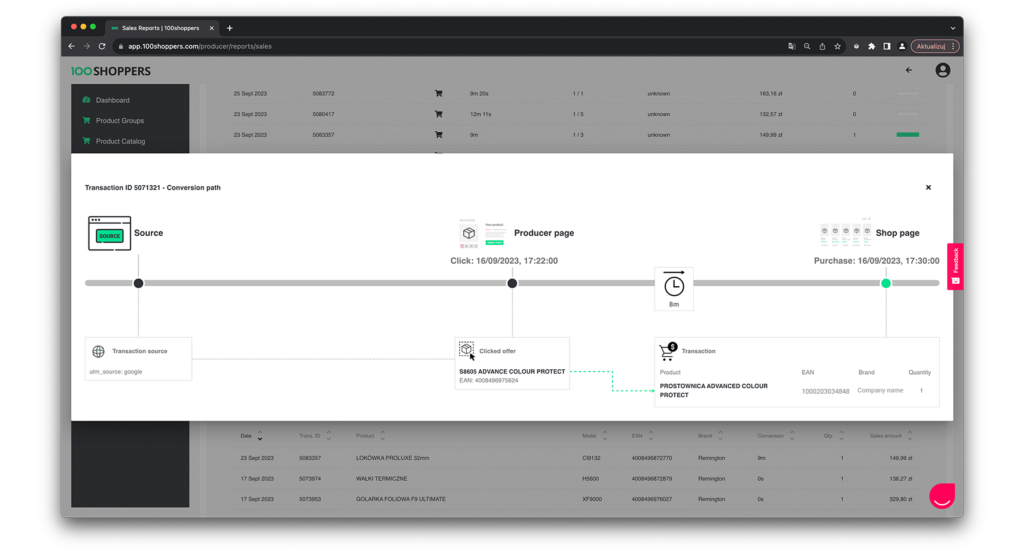What is the manufacturer’s view of the customer path to purchase? How to meet the challenges of directing traffic to the distribution network?
Following customer’s path to purchase on manufacturer’s end
According to data collected by Markinblog, there are around 26.5 million ecommerce sites active around the globe today, and this number is growing from day to day.
Bearing in mind that only in 2019 this number was three times lower, totalling 9,2 million online shops and platforms, the increase is really remarkable.
This unprecedented growth, impressive as it is, naturally entails the rise of competitiveness.
Barriers to entry for the ecommerce operators have become relatively low, requirements are easier to meet, so is price and product comparison for customers, which factors have been additionally driving the growth of online commerce.
Furthermore, the rise of advanced technologies has been stimulating the increase in competitiveness, providing tools and means that make adapting to volatile market realities hassle-free and seamless.
However, for brands (manufacturers) who cooperate with numerous online distributors the picture is far more complex. To manufacturers operating in the B2B2C distribution model, it is the goods from other manufacturers displayed next to theirs on ecommerce platforms that are the direct competition, as those items are often considered by customers as viable alternatives.
Therefore, selling with online downstream partners requires setting up a reliable customer path to purchase that would offer us a good head start and strategic advantage over our competition on all stages of the purchase process.
Keep reading to learn more about building a customer path to purchase that sells products and maintains high value for your partners and your customers.
The online path to purchase
The “path to purchase” term stands for the shopping journey that the customer embarks on from the moment they get interested in a product to making the actual transaction.
The path to purchase analysis and optimization are key processes aimed both at providing customers with the best shopping experience and improving the effectiveness of our sales.
There are a few stages to customer path to purchase:
- Awareness, the first touchpoint, when the customer first learns about our brand and interacts with it,
- Consideration, when the buyer identifies their unmet need, considers their intentions and undertakes actions that bring them closer to making the purchase decision,
- Purchase,
- Retaining customer’s loyalty,
- Brand Advocacy, the post-purchase stage, when the customer becomes our brand ambassador.
On every stage of the process, customers interact with our brand with a different set of expectations.
Not surprisingly, catering to the expectations at the early stages of the purchase path increases the chance that the customer completes the remaining steps and makes a buy.
It’s important to note that, according to the data gleaned by Google, users go through roughly 500 different touchpoints while interacting with a product or service before they decide to close the deal.
At the stage of building customer’s awareness of our product or brand online, the most frequent touchpoints between the customer and the offer are:
- Social media,
- Banner ads on website they visit,
- User referrals,
- Reviews and testimonials.
How relevant each of those touchpoints is for our process can be established based on the internal data sourced from our website with, for instance, Google Analytics.
When the customer moves forward to Consideration and Purchase stage, the touchpoints at play there are:
- Brand’s website or online store,
- Social media, especially content including reviews, product description and specification,
- Live chats and other forms of contact with sales representatives.
It’s important to note that in the B2C sales model, we are guiding a single customer down the sales path, who most often interacts with one single consultant.
In the B2B2 model, on the other hand, it takes engagement from a larger number of people to foster making one purchase decision.
Indeed, the decision stage relies greatly on turning the mundane shopping process into a memorable positive experience for the customer, be it on our own website or in an online store. A robust communication and marketing strategy on social media can additionally support the purchase decision.
Apart from that, social listening to chatter about our products and brand as they pop up on the internet can give us the authentic feel of how we are actually perceived by previous and future buyers.
Moving on to post-purchase stages on customer’s path, the following factors play a significant role in retaining the client and turning them into a repeat buyer:
- The quality of shopping experience and customer satisfaction,
- Referrals,
- Opinions and reviews,
- Social media,
- Email marketing and newsletter,
- Loyalty programs.
The role of post-purchase activities taken by the company itself in shaping customer’s decisions should not be downplayed. Loyalty Retention and Brand Advocacy are stages perfect for demonstrating company’s functional alignment when processing customers’ complaints or when dealing with returns, the most sensitive areas of customer satisfaction.
It cannot be stressed enough how crucial a customer-centric policy is when it comes to complaints and returns for building buyer loyalty.
A company should also consider a selection of marketing collaterals to play a role at the post-purchase stage. A way to bring the customer back to our store might be the upselling tactics, for example, sending personalized emails on complementary goods that go with their recent purchase.
Challenges faced by manufacturers in the online distribution network model
There are many sources that present detailed overviews on the types of marketing efforts to engage in at different stages of customer path to purchase, and how they are to be implemented and optimized.
Below, we will be focusing on the path to purchase from the perspective of manufacturers who distribute their goods in the network of online channel partnerships.
The main difference between the B2C and the B2B2C model is that the latter path involves an intermediary – the consumer purchases the product not directly from the manufacturer’s website, but indirectly, from an authorized online retailer.
For the brand (manufacturer), this additional point in the purchase process means confronting a couple of questions:
1. How to direct the user to the partnering channel?
Ideally, straight from the product page on the manufacturer’s website, buyers should land on the corresponding page in the online store, where they can make a purchase.
The key challenge here is directing the customer to those online stores that actually have the product in stock, in this way offering the customer the actual merchandise they sought for and an excellent shopping experience.
Manual integration of the manufacturer’s product list and retailer’s inventory would be excruciatingly time-consuming and prone to error. The challenge of integration opens up a wide range of possibilities for the automated technological solutions existing on the market today.
2. How to retain customer’s attention?
The process of redirecting the visitors from the manufacturer’s website to an online store can be highly sensitive due to the risk of failing to secure the user as a customer. Along the way, they can lose interest in our product in favor of the one offered by our competitors, they can stray away from our process while “special bargain” hunting, or continue their search in external price comparison engines.
3. How to acquire sales and traffic data?
As the sales process happens outside of brand’s website and on partnering channels, there exists significant risk that the relevant insights into customer behavior after they are redirected become inaccessible, or simply lost.
How to tackle the challenges of building a strong path to purchase in a distribution network?
All potential problems described above as probable challenges in the process of redirecting buyers from the manufacturer to the online store can be solved with the help of modern technology.
The Where To Buy widget from 100Shoppers is a sales management tool that transfers the buyer directly from the product page to the online shop that currently carries the product.
What is more, the user is taken straight to the data sheet of the item they have been browsing on the brand manufacturer’s site.
Eliminating the speed bump where the customer has to perform their search twice, one time on brand manufacturer’s website and the second time in an online store, is essential for two reasons:
- We can cut short the customer’s path to purchase,
- We can mitigate the risk of losing the customer in favor of our competition when the client goes through multiple offers in an online retail store.
Path purchase analysis on the manufacturer’s website
In their 100Shoppers management panel, the manufacturer can run an analysis of the customer’s path to purchase, from the first click on the manufacturer’s website to the moment the product is acquired. A comparison can be made between the time on site and the conversion time, also in relation to the shopping basket. The data available from the panel is presented both in a real-time view and historically over a period of time, which is perfect for trend analysis and preparing sales forecasts.

In conclusion
In their quest for quality and growth in the modern economic environment, manufacturers must choose solutions that favor automation over manual work, compactness over complexity, opportunity and diversity over orthodoxy. Eliminating unnecessary speed bumps on the path to purchase, like the already memogenic 404 error pages, are the basic standards of a customer-centric approach to doing business around the globe. There’s no reason whatsoever not to join the rest of the world in building a more sustainable market for all its participants.








